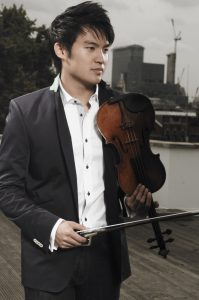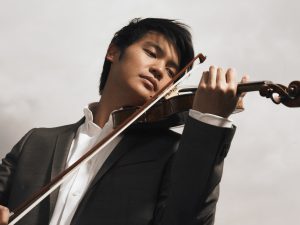San Diego Symphony Soars in Brahms and Sibelius
In recent years, the San Diego Symphony has chosen most of its guest soloists with the same status conscious eye that upscale shoppers use at Nordstrom and Nieman Marcus. Pianists such as Lang Lang and Garrick Ohlsson (already heard this month) and violinists Joshua Bell and Gil Shaham (we will hear them later in the symphony season) are the Gucci and Yves St. Laurent of the classical music world.

Ray Chen (photo by Chris Dunlop)
Friday’s (Oct. 26) Symphony concert proved a welcome exception to this name brand penchant, featuring the 23-year-old Taiwanese violinist Ray Chen in the Jean Sibelius Violin Concerto. Winning first prize in the 2009 Queen Elisabeth International Violin Competition in Brussels jump-started Chen’s concert career, although he has yet to attain A-list name recognition.
But it was refreshing to hear a new voice from the crowded roster of violin soloists, and Chen did not disappoint. From the opening phrases of the Sibelius we heard his sumptuous tone and sensed his undeniable empathy for the composer’s effulgent melodic expression.
I particularly liked his fiery cadenzas that sacrified not a whit of clarity and, at the other end of the scale, a gentle yet earnest expression of the composer’s brooding introspection. My sole reservation about his otherwise exemplary account was the occasional lapse of drive in the admittedly unconventional, sprawling first movement. I am eager to hear him again, say in the Barber or the Shostakovich Violin Concertos.
Music Director Jahja Ling and the orchestra conjured a luxurious accompaniment that brought out at every turn Sibelius’ brilliant orchestration, one that emphasizes those instruments in the lower ranges. It was a great evening for the horns and trombones, whose plangent chorales eloquently communicated the concerto’s Nordic grandeur.
Orchestral strength in the Sibelius was only a prelude to the Johannes Brahms Fourth Symphony that filled the program’s

Ray Chen (photo by Chris Dunlop)
second half. Ling presided over a masterful, beautifully detailed account of this symphony, one of the cornerstones of the symphonic canon. Working from memory, Ling stressed equally the orchestra’s suave sonic sheen and the dramatic surges that shatter it.
Of the inner movements, the deftly turned intimate instrumental conversations of the second movement (Andante moderato) and the almost martial cadence and cohesive rhythmic ensemble of the third (Allegro giocoso) demonstrated how far this orchestra has traveled under Ling’s tutelage. His interpretation of the finale (Allegro energico e passionato) found more gravity than passion in this grand passacaglia, but his approach allowed Brahms’ superlative counterpoint to stand out in even greater glory.
We were fortunate to hear some of the music of the esteemed American composer Aaron Jay Kernis this summer when he was in residence with La Jolla SummerFest. His “Too Hot Toccata,” an [php snippet=1] energetic, spicey overture, opened this concert with the same energy a Rossini overture so reliably does. But we have heard La gazza ladra far too many times, and “Too Hot Toccata” was welcome relief, even if at times it did sound like Leonard Bernstein on speed.
[box] This San Diego Symphony program repeats Saturday, Oct. 27, at 8:00 p.m. and Sunday, Oct. 28, at 2:00 p.m. at Copley Symphony Hall (750 “B” St., San Diego, CA 92101).
The next offering in the Jacobs Masterworks series is Gustav Mahler’s Fifth Symphony Nov. 2-4.
Tickets: 619.235.0804 www.sandiegosymphony.com[/box]

Ken Herman, a classically trained pianist and organist, has covered music for the San Diego Union, the Los Angeles Times’ San Diego Edition, and for sandiego.com. He has won numerous awards, including first place for Live Performance and Opera Reviews in the 2017, the 2018, and the 2019 Excellence in Journalism Awards competition held by the San Diego Press Club. A Chicago native, he came to San Diego to pursue a graduate degree and stayed.Read more…

I did not read this in any local newspaper today, but (yesterday) Sunday, the Symphony’s assistant conductor took over the first half of the program — presumably Ken-David Masur. Jahja Ling had a fall, if I understand correctly, but he managed to get to the hall in time and in good shape enough to conduct the Brahms. // With regard to Lang Lang and Ohlsson, I was told by somebody “who pays the checks” (or so he told me) that Lang Lang’s fee is way, way greater than Ohlsson’s fee. I mention this because I have always thought Ohlsson the greater artist, and Ohlsson did not sell out his SDS Sunday mat recently. I am a Sunday season subscriber and was sorry to see such a bad house.
Actually, the first half of the Sunday matinee was lead by upcoming guest conductor Christof Perick (who will lead the upcoming BEETHOVEN’S PASTORAL on November 16 – November 18, 2012). The entire orchestra’s eyes were glued to Mr. Perick because they didn’t know what to expect next, and they were “flying without a net.” Mr. Perick conducted with extreme verve and acute skill. It was akin to Leonard Bernstein’s last minute substitution with the philharmonic in NY that made him an instant star. The members of the SD Symphony were ALIVE, which is usually not the case. It was an electrifying performance!